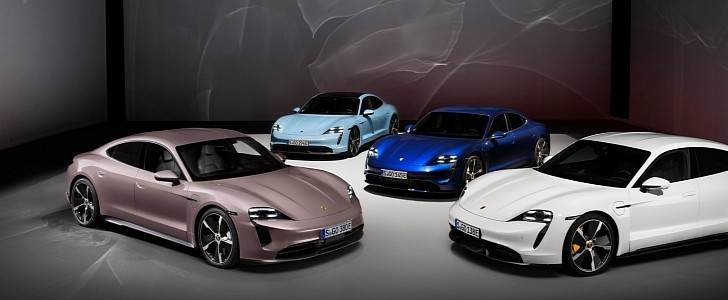Until now, there was always something after the Taycan branding keeping company to Porsche’s first EV. Now, the Turbo S, Turbo, and 4S models are being joined by a fourth version. Previously available only in China, the new variant is simply named Taycan and comes with rear-wheel drive and the lowest MSRP to date, undercutting the 4S by a considerable amount.
In the United States, the pricing nomenclature for the Taycan is a clear example of jumping scale. The Taycan 4S goes from at least $103,800, followed by the Taycan Turbo at almost $151k, and the flagship Taycan Turbo S that kicks off at $185k.
Now there’s a Taycan at the other end of the spectrum as well, and for the first time it goes below the $100k mark. Considerably lower, actually, as the new RWD version will arrive at U.S. dealerships in early spring 2021 with a MSRP of $79,900.
Not including the $1,350 delivery, processing and handling fee, there’s almost $24k (exactly $23,900, to be more precise) between the Taycan and the 4S. Of course, the savings do have their own cost; that could be treated as both bad and good news, depending on your angle of view.
The 2021 Taycan can be had only in RWD form, thus removing the mighty all-wheel-drive setup (as well as the front power unit). One might call this bad news but think about it – this means the Taycan is now around 200 pounds (90 kg) lighter.
Although the company hasn’t yet released details about the EPA range estimate, the RWD model does share the rest of the architecture – such as the rear power unit and battery – with the Taycan 4S. There are also two versions of the latter – the Performance Battery and the Plus version.
The former is good for a gross capacity of 79.2 kWh and has fast-charging capabilities at up to 225 kW. The Performance Battery Plus is both heavier (an additional 170 lbs/77 kg) and larger, with a gross capacity of 93.4 kWh and a maximum recharging speed of 270 kW.
Depending on the battery, the Taycan also comes with different power settings. The base setup has up to 402 horsepower (300 kW) and 254 pound-feet of torque (344 Nm), while the Plus brings 469 hp (350 kW) and 263 lb-ft (357 Nm). The performance comes down to a 5.1-second sprint to 60 mph (5.4 seconds to 100 kph) and a maximum speed of 143 mph (230 kph), regardless of the battery size.
By the way, the new Taycan is also coming to Europe, where it does get a WLTP-based range rating of 431 and 484 km for the two battery options (268 and 301 miles, respectively). The pricing is a bit different, though, with the home market of Germany getting the latest version from at least €83,520 (over $101k at the current exchange rates) from the middle of March.
Now there’s a Taycan at the other end of the spectrum as well, and for the first time it goes below the $100k mark. Considerably lower, actually, as the new RWD version will arrive at U.S. dealerships in early spring 2021 with a MSRP of $79,900.
Not including the $1,350 delivery, processing and handling fee, there’s almost $24k (exactly $23,900, to be more precise) between the Taycan and the 4S. Of course, the savings do have their own cost; that could be treated as both bad and good news, depending on your angle of view.
The 2021 Taycan can be had only in RWD form, thus removing the mighty all-wheel-drive setup (as well as the front power unit). One might call this bad news but think about it – this means the Taycan is now around 200 pounds (90 kg) lighter.
Although the company hasn’t yet released details about the EPA range estimate, the RWD model does share the rest of the architecture – such as the rear power unit and battery – with the Taycan 4S. There are also two versions of the latter – the Performance Battery and the Plus version.
The former is good for a gross capacity of 79.2 kWh and has fast-charging capabilities at up to 225 kW. The Performance Battery Plus is both heavier (an additional 170 lbs/77 kg) and larger, with a gross capacity of 93.4 kWh and a maximum recharging speed of 270 kW.
Depending on the battery, the Taycan also comes with different power settings. The base setup has up to 402 horsepower (300 kW) and 254 pound-feet of torque (344 Nm), while the Plus brings 469 hp (350 kW) and 263 lb-ft (357 Nm). The performance comes down to a 5.1-second sprint to 60 mph (5.4 seconds to 100 kph) and a maximum speed of 143 mph (230 kph), regardless of the battery size.
By the way, the new Taycan is also coming to Europe, where it does get a WLTP-based range rating of 431 and 484 km for the two battery options (268 and 301 miles, respectively). The pricing is a bit different, though, with the home market of Germany getting the latest version from at least €83,520 (over $101k at the current exchange rates) from the middle of March.













